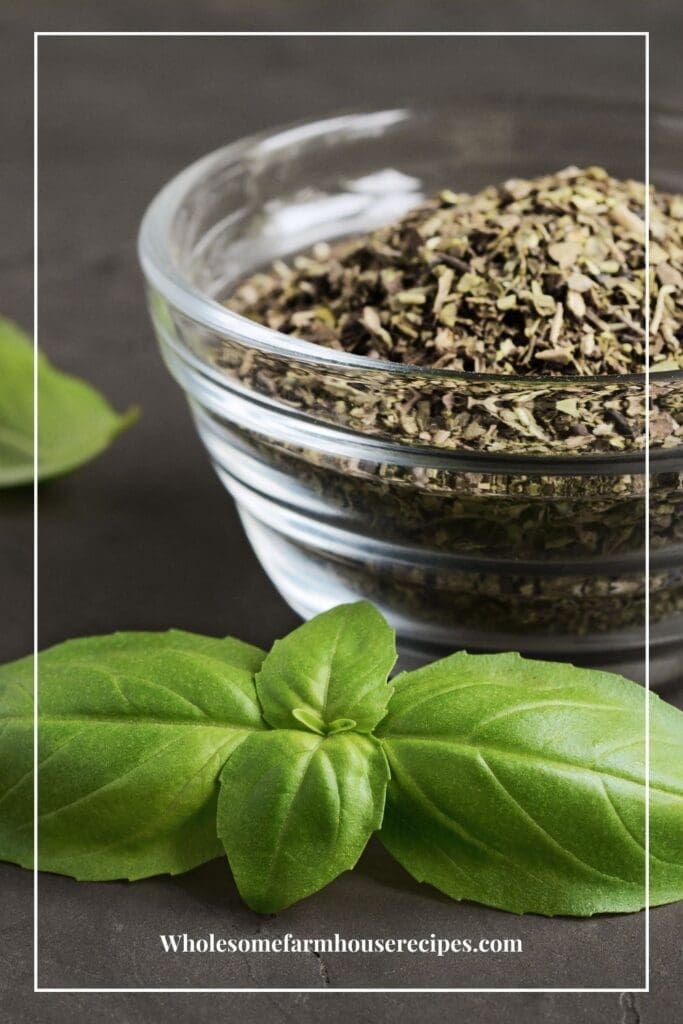How to Dry Fresh Basil: 4 Simple Ways. Drying basil is a great way to preserve your harvest and keep it on hand for later use. It’s easy to do, and you can dry it in a variety of ways. In this post, we’ll show you how to dry basil using four different methods. Read on to learn more!
Health Benefits of Basil
Basil is more than just a tasty herb to add to your cooking. This versatile plant also offers a range of health benefits. For instance, basil is a good source of antioxidants, which can help to protect the body from damage caused by free radicals.
Additionally, basil contains anti-inflammatory compounds that may help to reduce the risk of chronic diseases such as heart disease and arthritis.
Furthermore, basil has antibacterial properties that make it an effective natural remedy for certain infections. So, the next time you’re in the kitchen, don’t forget to add some basil to your meal – your body will thank you for it!

How to Preserve Fresh Basil
Our family loves to grow fresh herbs in pots on our patio during the summer months! It is so easy to do and you can reap the rewards all summer long. We love drying the whole leaves or adding fresh leaves to favorite dishes.
There is also something about using your own herbs from your herb garden and not having to run to the grocery store. However, it is sometimes hard to get to all of your basil to use in dishes before the plant grows out of control.
That is why I like to do two things; nip off the flower buds from the plant when they appear, and dry all the extra, fresh basil leaves throughout the season.
What should I do when my basil plant flowers?
When your basil plants flower, you will want to nip those buds off quickly to prevent bitterness in the leaves and the stagnation of its growth.
We want that plant to keep growing flavorful leaves all summer long, and the best way to do that is by pruning the dead ends and flower buds every couple of weeks. Personally, I like to put my basil plant in a high traffic area, so I am always able to pinch off flower buds as they appear.

Dried Basil versus Fresh Basil
Basil is a very versatile herb. Dried basil and fresh basil both have their own distinct flavors that can enhance the taste of various dishes.
Dried basil has a more stronger flavor than fresh basil, so it is often used in cooked dishes.
Fresh basil, on the other hand, has a more delicate flavor that is best appreciated in raw dishes. In general, fresh herbs are more perishable than dried herbs, so they need to be used more quickly. However, dried herbs can be stored for long periods of time and used as needed.
When cooking with dried herbs, it is important to remember that they should be added at the beginning of the cooking process in order to give them enough time to release their flavor. Fresh herbs can be added at any point during the cooking process.
Preparing Basil for Drying
You can dry whole plants, but I find the best method is to nip the individual leaves off of the plant. That way, your plant can keep on growing for the rest of summer. The next step is to wash and dry your basil leaves. One tip is to use a salad spinner to remove excess water.
How to Dry Fresh Basil: 4 Simple Ways.
Food Dehydrator Drying Method for Basil
A big benefit of using a food dehydrator to dry basil is that it provides good air circulation. To dry basil with the food dehydrator method, The first step is to layer whole basil leaves in a single layer on the dehydrator trays.
Set the machine to the lowest possible temperature. The basil will take anywhere from 4 to 10 hours to complete drying. You can dry lots of basil at once with this method as most dehydrators use vertical space. Remember to check your dehydrating basil regularly so it doesn’t become overdone and burnt.
Oven Drying Basil
The oven is a great option for drying large quantities of basil at a time. Begin by adding a single layer of leaves to a baking tray or cookie sheet. You can put down parchment paper first if you desire, but it is not necessary.
Make sure the leaves are not touching each other. Dry the leaves at the lowest temperature, about 170 degrees Fahrenheit, checking them often.

Air Drying Basil
I find the easiest way to dry basil is air drying. I use my kitchen counter, with nothing but paper towel. This method really takes the hard work out of it. Preferably, you would dry them in a dark place, but if your kitchen can be dim, use that or another room in your home that can be undisturbed.
I layer a single layer of basil leaves onto paper towel and allow them to dry at room temperature. It can take anywhere from 6 hours to a day or more for basil to air dry depending on the humidity of your home.
Dry Basil in the Microwave
You may be surprised, but you can also dry your basil in the microwave. This is a very quick and easy method, but needs to be done carefully.
Start by doing three bursts of 30 seconds, then follow by bursts of 10 seconds until it is crisp. Note that basil will dry slightly more as it cools. Allow the basil to cool completely before crumbling into your favorite jar.
How to tell if basil is dry
Drying basil is easier than you may think. It is easy to tell if basil is dry if it crumbles easily when you touch or handle it.

How to store dried basil
You can store freshly dried basil in any air-tight container, but people often use spice jars. I use whatever glass jar I have on hand or even recycle another airtight container.
Make sure to put a label on it and a date so you know when to use your dry leaves by. Also, you can leave your basil leaves whole, or crumble them up so they are easy to shake, pour, or scoop out.
Recipes using basil
How to Dry Fresh Basil: 4 Simple Ways
Kitchen Essentials
Materials
- Fresh Basil
- Any Fresh Herb such as parsley, cilantro, and mint
Instructions
- Food Dehydrator Drying Method for Basil
- A big benefit of using a food dehydrator to dry basil is that it provides good air circulation. To dry basil with the food dehydrator method, The first step is to layer whole basil leaves in a single layer on the dehydrator trays.
- Oven Drying Basil
- The oven is a great option for drying large quantities of basil at a time. Begin by adding a single layer of leaves to a baking tray or cookie sheet. You can put down parchment paper first if you desire, but it is not necessary.
- Air Drying Basil
- I find the easiest way to dry basil is air drying. I use my kitchen counter, with nothing but paper towel. This method really takes the hard work out of it. Preferably, you would dry them in a dark place, but if your kitchen can be dim, use that or another room in your home that can be undisturbed.
- Dry Basil in the Microwave
- You may be surprised, but you can also dry your basil in the microwave. This is a very quick and easy method, but needs to be done carefully.
Notes
How to tell if basil is dry
Drying basil is easier than you may think. It is easy to tell if basil is dry if it crumbles easily when you touch or handle it.Other recipes to check out.







